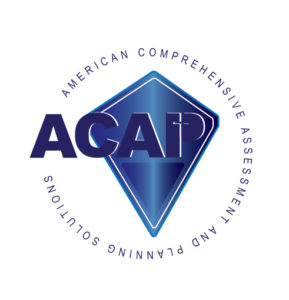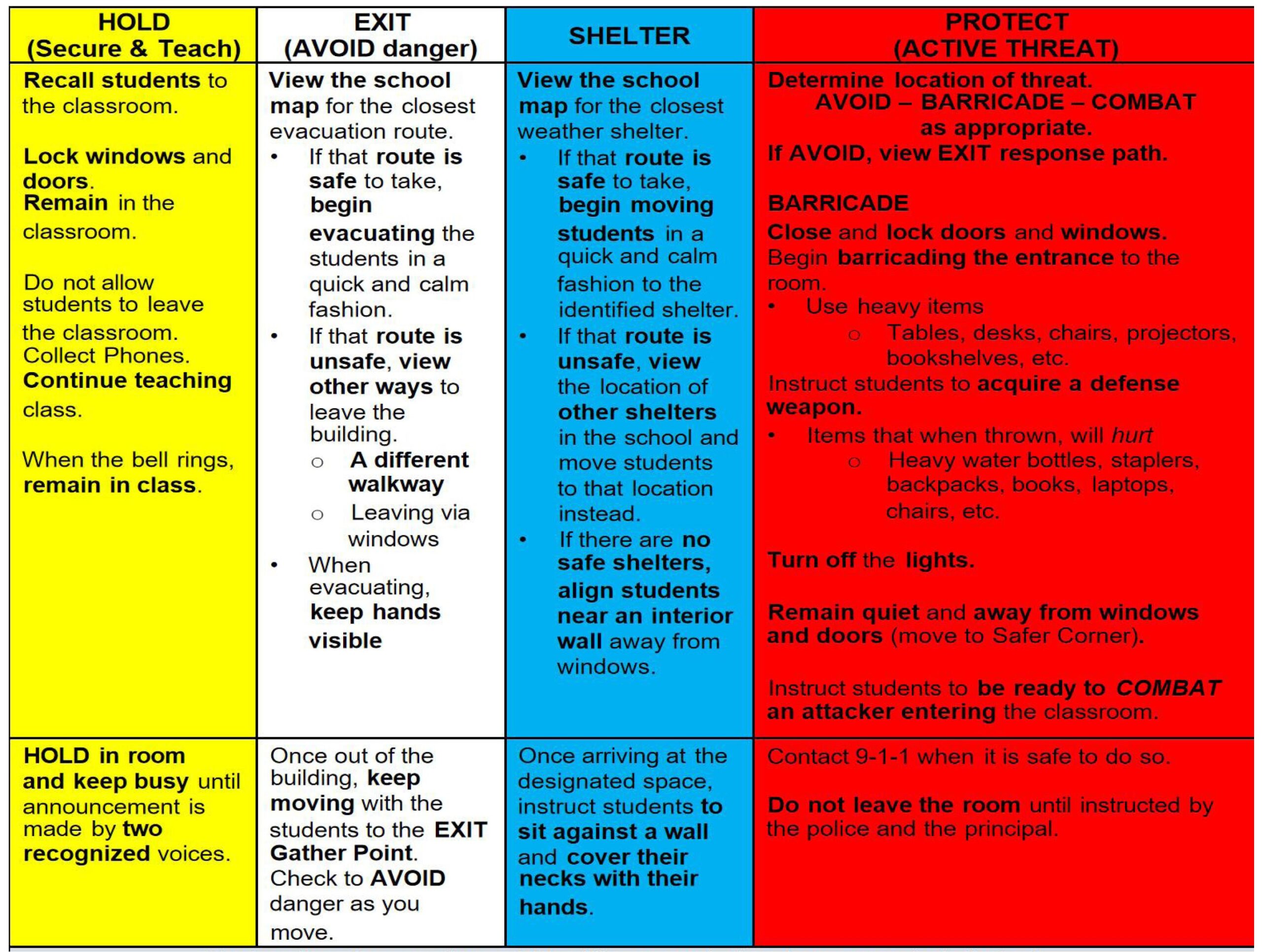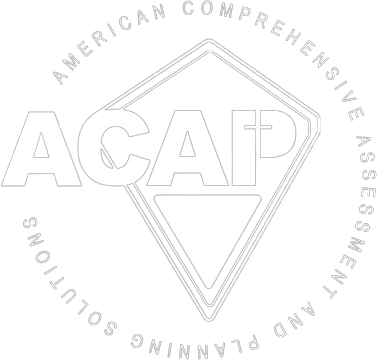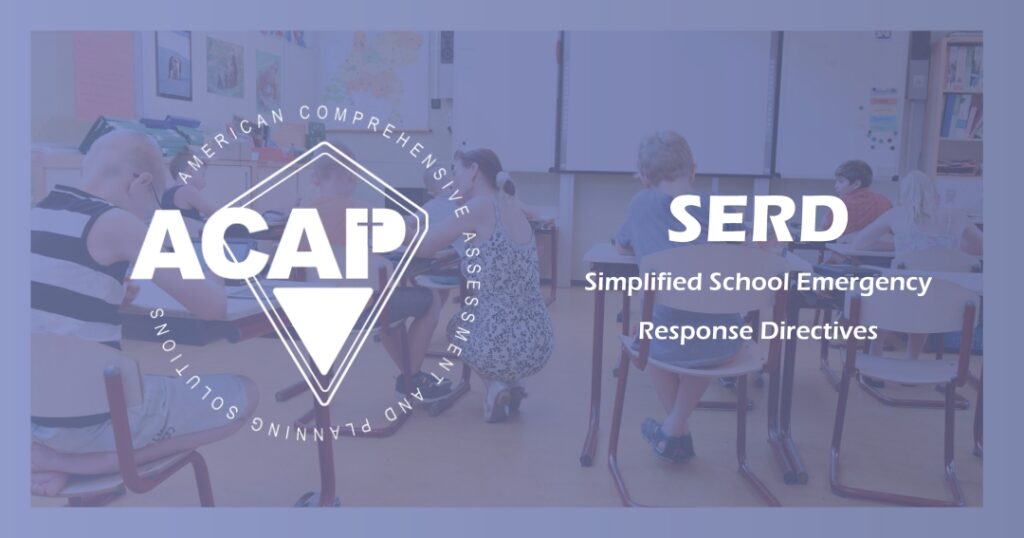Training Staff on SERD
Instructions for Incident Response Training of Staff at Schools
 All emergency actions follow the same five steps:
All emergency actions follow the same five steps:
- Grab your Kit
- Gather your Kids
- AVOID Danger
- Move
- Check-in
Below are more detailed explanations.
Preliminary Behaviors
All response paths in emergency scenarios will follow the same set of behaviors. The staff member should secure away to communicate with the School Administrator/outside. Room staff will also be responsible for taking the “go-kit” or emergency kit for their area. In most cases, this container will be in a classroom and will therefore include items like the class roster, backup medications for the students in that classroom, a first-aid kit, bottled water, snacks, communication cards, and maps. For certain staff, these backpacks may include more thorough versions of the listed items. The final step in the preliminary behaviors is to gather students. Teachers will be gathering the students in their class. For other faculty and staff, this may be students in the nearby hallways or vicinities. Staff will instruct the students to remain calm, stay quiet, and listen for the next instructions.
Depending on the situation, the adult will then identify which response path to take: Secure & Teach, Exit, Shelter, or Active Threat – Protect.
Secure & Teach
After completing the preliminary behaviors, the adult will recall all students back to the classroom. After students have returned from bathrooms or halls, lock the windows and doors. Then, continue teaching class as usual. Do not allow students to leave the classroom for requests, transition bells, or end of day bells. Stay in Secure & Teach until an announcement is made by two recognized voices that it is safe to transition.
When it is safe to do so, review the class roster and identify which students are accounted for and which students are not. Further, identify what students have injuries or may need medical attention. Then, communicate with School Administration and inform them of their status. Using telecommunications or apps is acceptable.
Exit
After completing the preliminary behaviors, the adult will refer to the school map for the closest evacuation route. Look outside of the classroom to determine if evacuating the classroom is safe at that time. If that route is safe to take, begin evacuating the students in a quick and calm fashion. If that route is unsafe, view other ways to leave the building. This can include a different walkway, or, in more extreme circumstances, leaving via windows.
Once evacuated from the building, keep moving the students until reaching the evacuation site – this is where the site specific location is inserted. In situations of active violence, contact 9-1-1 when it is safe to do so. Helpful information to include will be location, number of individuals in that location, injuries in that location, and any information of the perpetrator of the violence such as the number of perpetrators, their location(s), their weapon(s), their physical description(s).
When it is safe to do so, review the class roster and identify which students are accounted for and which students are not. Further, identify what students have injuries or may need medical attention. Then, communicate with School Administration and inform them of their status.
School Administration will make the determination whether to return to school or move to Reunification.
Shelter
After completing the preliminary behaviors, refer to the school map for the closest approved shelter area. If that route is safe to take, begin moving students in a quick and calm fashion to the identified shelter. If that route is unsafe, view where other shelters are in the school and move students there. If there are no safe shelters, align students near an interior wall away from windows.
Once arriving at the safe space, instruct students to sit down against an interior wall away from windows and cover their necks with their hands.
When it is safe to do so, review the class roster and identify which students are accounted for and which students are not. Further, identify what students have injuries or may need medical attention. Then, communicate with School Administration and inform them of their status.
Active Threat – Protect
After completing the preliminary behaviors, staff should attempt to determine the location of the threat to determine whether they should AVOID or Barricade. If the threat is farther away (the other side of the building), AVOID by following the steps in the EXIT Response path. If the threat is closer in proximity, begin the process of Avoid-Barricade- Combat. The beginning of these behaviors is often closing and locking the doors and windows that provide access to the space. Following this, the most critical behavior is to Barricade, not hide. Adults and students should begin Barricading the entrance to the room. Various objects can be used including, but not limited to tables, desks, chairs, moving whiteboards, projectors, and bookshelves. At this point, creating a separating obstacle is more important than the noise moving those items may create. Once Barricaded, instruct students to acquire an item that can be used for defense if the attacker enters the classroom, or breaches the safety zone. Typical classroom items that can be used include, but are not limited to, heavy water bottles, staplers, backpacks, books, laptops, and chairs. After everyone is prepared, turn off the lights, remain quiet, and move students away from windows and doors to the safer corner in the room. Instruct students to be ready to throw their defense weapons at anyone breaching the safety zone.
When it is safe to do so, contact 9-1-1. Helpful information to include will be location, number of individuals in that location, injuries in that location, and any information of the perpetrator of the violence such as the number of perpetrators, their location(s), their weapon(s), their physical description(s). When it is safe to do so, review the class roster and identify which students are accounted for and which students are not. Further, identify what students have injuries or may need medical attention. Then, communicate that information to School Administration.
**SERD is a proposed response protocol from ACAP. It maybe reproduced without permission, so long as authorship is acknowledged.**
Contact us today to discuss your district’s needs, schedule a consultation and determine the perfect retainer package for your school district’s safety!
Response Paths by Directive for Staff
Each path follows 5 behaviors:
- Grab the “go-kit”/emegency kit (i.e., student roster, medications, first-aid kit, bottled water, snacks, communication cards, maps, etc.) & communication device (i.e., cellphone, walkie-talkie, pager, etc.)
- Gather the students and instruct them to listen for the next step of the plan.
- AVOID danger – always continue to check the path ahead. Be ready to change paths or responses.
- MOVE – go to the area designated by the command

Review the class roster and identify accounted and unaccounted students.
Identify which injured students or those who may need medical attention.
5. Check-in – Communicate this information with Person in Charge when it is safe to do so.


